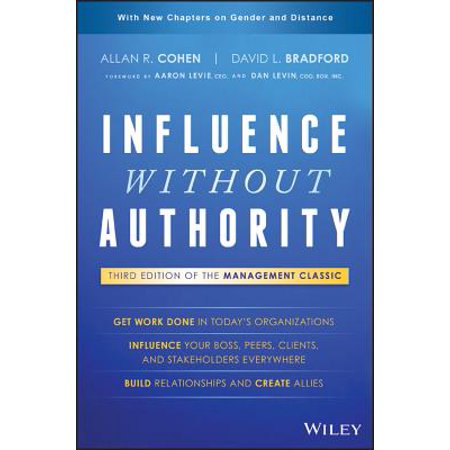In many ways, this book could not have come at a better time in my career. I had been part of several cross-functional teams, worked with clients who were not direct reports, and tried influencing decisions without having any formal title or power. And more often than not, I hit a wall. That was until I stumbled upon Influence Without Authority by Allan R. Cohen and David L. Bradford.
Reading this book felt like sitting down with two wise coaches who understood exactly what it meant to work in modern organizations, where influence often matters more than hierarchy. It challenged some long-held beliefs I had about leadership, control, and persuasion. And more importantly, it gave me tools that I now use almost every day, in conversations, collaborations, and coaching sessions.
If you’ve ever had to lead a project without the title to match, or if you’ve struggled to align stakeholders who don’t report to you, this book might feel like the playbook you didn’t know you needed.
Let me walk you through a few powerful lessons from the book and how they’ve helped me in real-world workplace scenarios.
Influence Is Not About Power, It’s About Exchange
Table of Contents
The central idea of the book is both simple and profound. Influence comes from exchange. When you do not have authority over someone, you cannot order or demand. But you can offer something of value in return for what you seek. That something is what the authors call “currencies.”
This approach instantly made sense to me. We are wired for reciprocity. And in the absence of hierarchy, influence becomes less about persuasion and more about understanding. Understanding what the other person values and how that aligns with what you are asking for.
The beauty of the model is its realism. It does not rely on charm, charisma, or manipulation. It asks you to become observant, intentional, and strategic. And above all, it asks you to stop seeing influence as a one-sided act and start treating it as a mutual process.
Lesson 1: Assume All Are Potential Allies
“Assuming goodwill is not naive, it’s strategic.”
This is one of the first lessons that struck me deeply. I had often gone into meetings with defensiveness, especially if the other person had previously resisted or ignored my ideas. But the authors encourage a different mindset, to assume that everyone can be a potential ally.
This requires a shift. Our education systems reward competition. Our workplaces can subtly reinforce silos. But collaboration begins when we reframe people not as threats, but as possible partners.
I began practicing this mindset by softening my internal narrative before tough conversations. Instead of thinking, “They never support this,” I would tell myself, “What if they just need a reason to care?” That single change in mental script changed my tone, my energy, and often, the outcome.
Takeaway: Teach influence as a relationship-building skill, not a persuasion technique. Start with trust. See Building High Trust Teams for programs that support this shift.
Lesson 2: Get Clear on Your Objectives
In a rush to persuade, I used to lose track of what I actually wanted. The book emphasizes the importance of goal clarity. You must know exactly what you want from the other person before you can think about what to offer them.
That clarity also allows flexibility. When your goal is clear, your strategy can adapt. But when your ask is vague, even the best persuasion tactics will fail.
Now before any pitch or alignment conversation, I write down two things, my non-negotiables and my nice-to-haves. It keeps me grounded and helps me navigate pushbacks with calm rather than confusion.
Takeaway: Build goal-setting frameworks into influence and collaboration training. Influence without clear goals creates frustration instead of progress.
Lesson 3: Understand the Currencies That People Value
This is where the model really comes alive. Cohen and Bradford outline five types of currencies, categories of value that people care about in a workplace context:
- Task-related currencies
- Relationship-based currencies
- Inspiration-based currencies
- Position or status-based currencies
- Personal or self-concept currencies
Let me break these down with examples from my own experience.
Task Currencies: Help Me Get the Job Done
These are all about practical support. People who value task currencies care about efficiency, resources, or tangible results.
I once needed a colleague’s help on a cross-functional dashboard, but they were swamped. Instead of just asking for a favor, I offered to write the first draft of a section they were struggling with. In return, they made time to align on the data inputs I needed. That was task-based exchange, simple, fair, and fast.
Relationship Currencies: Make Me Feel Included
Some people value connection more than completion. They want to be included, heard, and appreciated.
This clicked for me while working with a team member who often seemed resistant to collaboration. I later realized they felt left out of earlier decisions. When I took time to loop them in earlier and acknowledged their past work, they became more open to feedback.
Inspiration Currencies: Show Me Purpose
These people are driven by meaning, mission, and values. You earn influence with them by connecting your request to a larger purpose.
I remember aligning a team around a reporting process nobody liked. The turning point came when we tied the effort to better visibility with customers. When the work became about impact, not just Excel, they got on board.
Position Currencies: Respect My Role
For people who value recognition and reputation, you influence them by offering visibility, status, or credibility.
A junior analyst I once mentored lit up when I gave them a shoutout during a leadership review. After that, they were proactive, responsive, and creative. Recognition was the currency that unlocked their potential.
Personal Currencies: Align With My Identity
These are the most subtle. Some people are influenced when their personal values, self-concept, or passions are acknowledged.
A colleague I worked with was very proud of their “problem-solver” identity. When I framed my ask as a puzzle that only they could crack, they took it up enthusiastically.
Takeaway: Train managers to observe what drives their teams and tailor their leadership style accordingly. Influence grows when currency is matched.
Lesson 4: Build Relationship Capital Before You Need It
This one is a game-changer. The authors caution against using the exchange model transactionally. Influence cannot begin only when you need something. It begins when you show up consistently, when you invest in trust, help without agenda, and build goodwill.
I have made this mistake in the past. I ignored relationship-building with certain peers until the moment I needed their support. And by then, the foundation was weak.
Now I try to create relationship deposits regularly. I offer help. I ask for input. I celebrate their wins. That way, when the time comes for a big ask, it feels natural, not forced.
Lesson 5: Influence Is Not Manipulation
This is one of the most important distinctions the book makes. Influence is not about tricking someone. It is about aligning interests. It is about solving for both sides. That is what makes it ethical and sustainable.
I used to hesitate using the word “influence” because I feared it sounded political. This book helped me see it differently. Influence, when done well, is a leadership skill. It is a way of getting things done in complex systems where authority is rarely absolute.
Even children use influence. They cry, smile, negotiate. Influence is part of human interaction. What makes it good or bad is the intent behind it.
Final Thoughts: Why This Book Matters More Than Ever
As organizations flatten, as matrix teams become the norm, and as collaboration becomes more cross-functional than ever, the skill of influencing without authority is no longer optional. It is essential.
Whether you are managing up, working across teams, driving change, or launching a new idea, the ability to influence others without formal power is what separates those who can create momentum from those who stay stuck.
This book gave me not just the mindset, but the method. It helped me reframe resistance as lack of alignment, not lack of intelligence. It helped me become curious, not forceful. And it reminded me that every meaningful exchange starts with understanding, not insistence.
A Takeaway for Every Workplace
In every organization, we have people who feel stuck. They know what needs to happen, but they do not feel empowered to make it happen. This book is a reminder that power is not always granted. Sometimes, it is earned through empathy, clarity, and connection.
We do not need titles to lead. We need tools. And Influence Without Authority offers exactly that, a thoughtful, practical, and deeply human guide to getting things done together.










